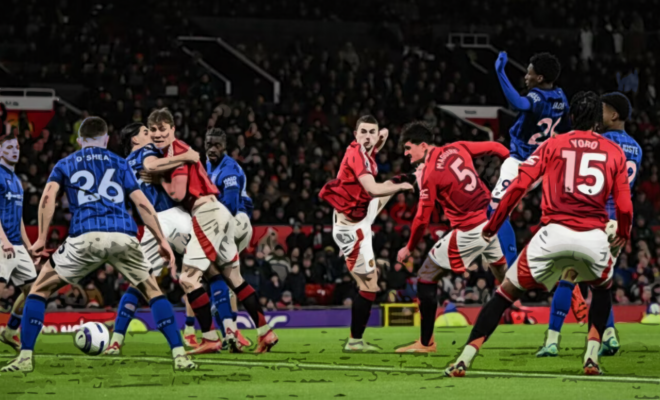Counter-Attacking Prowess: What Arsenal Can Learn from Forest’s Draw

In the high-stakes arena of modern football, tactical flexibility reigns supreme. For Arsenal, a team renowned for its attacking verve, the ability to dismantle varied defensive strategies is paramount. A recent encounter between Arsenal and Nottingham Forest, culminating in a goalless draw, serves as a potent lesson in the art of counter-attacking football and defensive resilience. This article delves into Nottingham Forest’s tactical blueprint, dissecting how they effectively nullified Arsenal’s attacking forays and threatened on the break. By understanding Forest’s approach, Arsenal can glean invaluable insights into fortifying their attacking transitions and manufacturing clear-cut chances against counter-attacking opponents.
Nottingham Forest’s stalemate against Arsenal was a masterclass in defensive discipline and counter-attacking efficiency. The Tricky Trees showcased a blueprint for frustrating even the most potent attacks.
Forest’s Defensive Organization: A Foundation for Frustration
At the heart of Nottingham Forest’s success against Arsenal lay their unwavering defensive organization. Forest’s ability to maintain a compact shape, deny space in critical areas, and thwart Arsenal’s attacking combinations underscored the importance of a well-drilled defensive structure.
- Defensive Set-Up: Forest went into the match unbeaten on home turf since September, a record they maintained against the Gunners, where they deployed a stern defensive rearguard.
- Compact Shape: Maintaining a compact shape, both horizontally and vertically, Forest stifled Arsenal’s attempts to play through the lines.
- Denying Space: Forest’s defenders diligently closed down space in and around the penalty area, limiting Arsenal’s ability to create clear-cut scoring opportunities.
- Thwarting Combinations: Forest’s defenders effectively disrupted Arsenal’s attacking combinations, preventing them from stringing together intricate passing sequences.
- Goalkeeper: Sels made a crucial save to deny Merino’s header from a Rice corner.
- Defensive Blocks: Murillo made an outstanding goalline clearance to keep out Odegaard.
Analyzing Nottingham Forest’s Counter-Attacking Approach
To fully appreciate Nottingham Forest’s strategy against Arsenal, it’s essential to dissect their counter-attacking approach and understand how they transitioned from defense to attack. While specific formations and personnel may vary, the underlying principles remain consistent:
- Quick Transitions: Forest were happy to soak up the pressure before hitting Arsenal on the counter.
- Exploiting Space: Forest’s counter-attacks were characterized by swift, direct runs into the space left behind by Arsenal’s advancing players.
- Clinical Finishing: While Forest failed to find the net against Arsenal, their counter-attacking approach often yielded high-quality scoring opportunities, underscoring the importance of clinical finishing.
- Individual brilliance: Gibbs-White cleverly put Wood in on goal.
- Gibbs-White to Wood: Morgan Gibbs-White sent Wood through on goal, but Forest’s top scorer was brilliantly halted by Gabriel.
Arsenal’s Attacking Shortcomings
To comprehend how Arsenal can counter teams like Nottingham Forest, it’s crucial to dissect their attacking performance in the 0-0 draw. By analyzing Arsenal’s attacking setup, we can identify key areas for improvement:
- Inability to Break Down Defenses: Arsenal struggled to penetrate a well-organized defense, often finding themselves stifled in the final third. They lacked the width, movement, and incisiveness to unlock the opposition’s backline and create clear-cut scoring opportunities.
- Lack of Clear-Cut Chances: Despite dominating possession and territory, Arsenal struggled to create clear-cut scoring opportunities against Nottingham Forest.
- Struggled in Front of Goal: Apart from Odegaard’s two missed chances in an offside position, Partey’s dragged effort late on summed up a frustrating time in front of goal.
- Midfielders: Merino and Tierney came close.
- Set piece threat: Corners continued to cause problems for Forest – Tierney headed our next one wide at the near post after good work from Timber to earn the set piece.
- First half struggles: Arsenal looked better in the final third compared to their defeat to West Ham United, their makeshift frontline, with Merino at the top, was unable to muster a shot on target in the first half.
- Individual errors: Odegaard had a shot cleared off the line as we entered the final 10 minutes, though Alex Zinchenko was flagged offside.
Arsenal’s Potential Attacking Evolution
Drawing inspiration from Nottingham Forest’s defensive resolve, Arsenal can adopt several strategies to enhance their attacking transitions and unlock well-organized defenses:
- Enhancing Attacking Transitions: Arsenal must sharpen their attacking transitions, developing the ability to quickly turn defense into attack and exploit spaces left behind by the opposition.
- Adding more energy: Ryan Yates and Danilo were introduced to try and inject some energy into the middle of the park.
- Improving chance conversion: Arsenal need to improve their ability to convert dominance into goals, developing the composure and clinical edge required to capitalize on scoring opportunities.
- Varied Attacking Approaches: Arsenal’s manager should encourage the team to vary their attacking approaches, combining patient build-up play with quick transitions and direct attacks. This will make it more difficult for opposing defenses to anticipate their moves and stifle their creativity.
- Individual Skill: Arteta should encourage individual brilliance and improvisation in the final third, empowering players to take on defenders, create space, and deliver incisive passes. This will add a new dimension to Arsenal’s attack and make them less predictable.
- Improve the frontline: Arteta said that Arsenal will not stop fighting for the Premier League title despite the gap to leaders Liverpool.
Arteta’s Tactical Adjustments
To implement these changes, manager Mikel Arteta may consider several tactical adjustments to maximize the attacking potential:
- Formation Flexibility: Arteta may experiment with different formations to provide greater attacking flexibility, potentially deploying a 4-2-3-1 or a 3-4-3 to create overloads in midfield and wide areas.
- Strategic Substitutions: Arteta should be prepared to make strategic substitutions to inject fresh energy and creativity into the attack, introducing players with the pace, skill, and tactical awareness to unlock stubborn defenses.
- Targeted Training Drills: Arteta should implement targeted training drills to improve the team’s ability to transition quickly from defense to attack, exploit spaces in the opposition’s defense, and convert dominance into goals. These drills should focus on enhancing communication, coordination, and tactical understanding.
Potential Arsenal Lineup Changes
To fully realize their attacking potential, Arsenal may consider strategic changes to their lineup:
- Pace and Skill on the wings: Arsenal could benefit from starting wingers known for their pace, skill, and ability to beat defenders, stretching opposing defenses and creating opportunities for overlapping full-backs and central midfielders.
- Creative Midfielders: Arsenal should prioritize selecting midfielders who excel at dictating play, creating chances, and providing incisive passes to unlock stubborn defenses.
- Strikers with Clinical Finishing: Arsenal should prioritize a striker known for his clinical finishing and ability to convert chances, ensuring that the team capitalizes on their attacking dominance.
Concluding Thoughts: Overcoming the Counter-Attack
For Arsenal to evolve into a Premier League-winning team, mastering the art of overcoming counter-attacking opponents is paramount. By drawing inspiration from Nottingham Forest’s defensive resolve and implementing similar strategies, Arsenal can transform their attacking transitions, unlock well-organized defenses, and add a new dimension to their offensive game.
Through a combination of tactical adjustments, player development, and a collective commitment to attacking football, Arsenal can become a more complete and formidable attacking force. The path to overcoming counter-attacking opponents is paved with hard work, tactical innovation, and a relentless pursuit of perfection – a challenge that Arsenal must embrace if they are to realize their full attacking potential and achieve their ambitions of Premier League glory.








